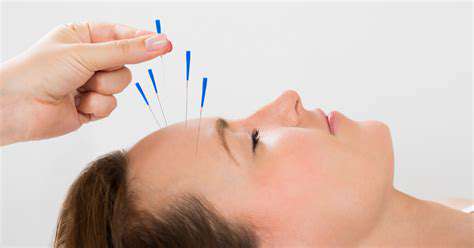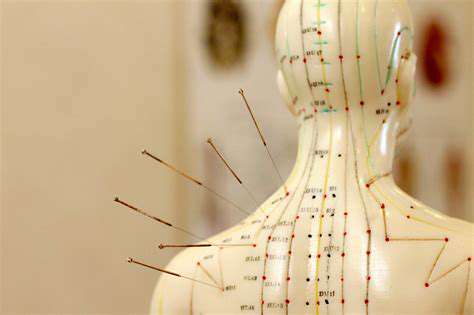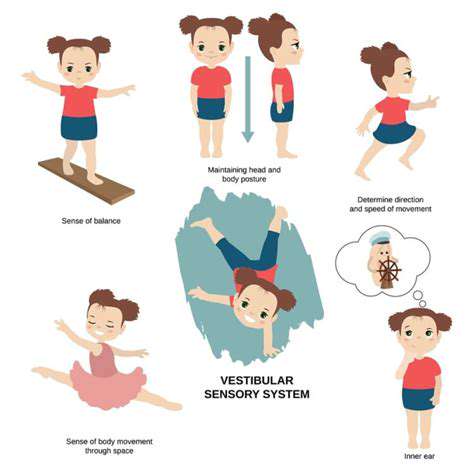TCM for Migraines: A Holistic Treatment Plan

Understanding Migraine
Migraines are debilitating headaches characterized by severe throbbing pain, often on one side of the head. They can be accompanied by nausea, vomiting, and extreme sensitivity to light and sound. This intense pain significantly impacts daily life, often requiring individuals to withdraw from work or social activities. Understanding the triggers and potential relief methods for migraines is crucial for managing this condition effectively.
Migraines can vary in intensity and duration, with some episodes lasting hours while others can persist for days. Identifying personal migraine triggers, such as stress, certain foods, or environmental factors, can be essential for preventative measures.
The Science Behind Acupuncture
Acupuncture, an ancient Chinese healing technique, involves inserting thin needles into specific points on the body. These points, known as acupoints, are believed to influence energy flow, or Qi, throughout the body. The theory is that by stimulating these points, acupuncture can restore balance and alleviate pain.
While the exact mechanisms are still being studied, research suggests that acupuncture may trigger the release of endorphins, natural pain-relieving chemicals in the body. This release could contribute to the pain-reducing effects observed in some individuals.
Acupuncture Techniques for Migraine
Acupuncture treatments for migraines often involve targeting specific acupoints believed to affect the nervous system and alleviate pain signals. These targeted points are often located on the head, neck, and shoulders, reflecting the typical location of migraine pain.
Different types of needling techniques are employed, such as inserting the needles quickly for stimulating pain relief or more slowly for a more relaxing effect. The duration of each treatment can also vary depending on the individual's response and the severity of the migraine.
Potential Benefits of Acupuncture
One potential benefit of acupuncture for migraine relief is its ability to reduce the frequency and intensity of migraine attacks. Studies suggest that regular acupuncture sessions can help to regulate the nervous system and create a more balanced state, potentially reducing the likelihood of migraine episodes.
Beyond pain relief, some individuals report improved sleep quality and reduced stress levels following acupuncture treatments for migraines. These complementary benefits can further enhance overall well-being.
Acupuncture and Other Treatments
Acupuncture is often used as a complementary therapy alongside conventional medical treatments for migraine. It can provide additional relief and support for those who experience chronic or debilitating migraine symptoms.
Considering acupuncture as an adjunct to existing therapies can be a valuable strategy for managing migraine. It is essential to discuss this approach with a healthcare professional to determine if it is a suitable option.
Safety and Considerations
While generally considered safe, acupuncture carries potential risks, including infections and bruising at the needle insertion points. Professional training and certification are crucial for ensuring the safety and effectiveness of acupuncture treatments.
It's vital to consult with a licensed acupuncturist who can assess individual needs and tailor the treatment plan accordingly. This approach helps to maximize benefits while minimizing potential risks.
Finding a Qualified Practitioner
Finding a qualified and experienced acupuncturist is essential for a successful experience. Look for practitioners licensed and certified by recognized organizations. Thorough research and recommendations from trusted sources can help in locating a suitable practitioner.
Prior to initiating acupuncture treatment for migraine, it is essential to discuss potential interactions with existing medications with both your acupuncturist and your primary care physician.
Herbal Remedies: Natural Approaches to Migraine Management
Traditional Chinese Medicine (TCM) Perspective on Migraines
Traditional Chinese Medicine (TCM) views migraines as a disruption in the body's vital energy flow, or Qi. This imbalance can manifest as various symptoms, including headache pain, nausea, and sensitivity to light and sound. TCM practitioners believe that migraines stem from a combination of factors, such as stress, poor diet, and environmental factors, all contributing to the stagnation of Qi within the body. Understanding this perspective is crucial when considering TCM approaches to migraine management, which often focus on restoring the balance of Qi.
A key concept in TCM is the importance of identifying the specific pattern of imbalance contributing to the migraine. Different patterns, such as Liver Qi stagnation, Kidney deficiency, or Blood stasis, might require different treatment strategies. This personalized approach acknowledges the unique needs of each individual experiencing migraines, highlighting the potential effectiveness of TCM in addressing the root cause rather than merely treating the symptoms.
Dietary Considerations in TCM Migraine Management
TCM emphasizes the connection between diet and overall health, including migraine management. Certain foods and beverages are believed to exacerbate migraines, while others can promote balance and well-being. A TCM practitioner might advise avoiding foods high in caffeine, processed sugars, or certain types of alcohol, as these are often associated with exacerbating migraine symptoms. Instead, they might suggest incorporating foods rich in nutrients like ginger, ginseng, and certain fruits and vegetables that are believed to support the body's natural healing processes.
The emphasis on specific dietary recommendations aligns with the holistic approach of TCM. Instead of simply recommending avoiding triggers, TCM practitioners often suggest specific foods that can support the body's natural ability to regulate Qi and balance the nervous system. This holistic approach to dietary choices extends beyond simply avoiding triggers, aiming to cultivate a balanced diet conducive to overall well-being.
Acupuncture and Moxibustion for Migraine Relief
Acupuncture, a cornerstone of TCM, involves inserting thin needles into specific points on the body to stimulate the flow of Qi. These points are believed to be connected to meridians, pathways that carry vital energy throughout the body. When applied to migraine treatment, acupuncture aims to restore balance to the meridians associated with the head and neck, potentially alleviating pain and reducing the frequency of migraine attacks. The precise location of the acupuncture points and the duration of treatment are determined by the practitioner based on the individual's specific condition.
Moxibustion, another TCM technique, involves burning dried mugwort herb near specific acupuncture points. This creates a gentle heat that is believed to enhance blood circulation and promote the flow of Qi. The combination of acupuncture and moxibustion can create a synergistic effect, potentially offering a more comprehensive approach to migraine management. This approach to pain relief emphasizes the subtle yet powerful interaction between the body's energy system and the therapeutic application of heat and pressure.
Herbal Remedies in Migraine Management
A variety of herbal remedies are employed in TCM to manage migraines, often in combination with other treatments. These herbs are carefully selected based on their ability to address the specific imbalances contributing to the migraine. For example, certain herbs are known for their calming effects, potentially reducing the intensity of migraine pain, while others are used to promote blood circulation and alleviate inflammation. The selection of specific herbal remedies and their dosages are tailored to the individual patient.
Herbal remedies, when used as part of a comprehensive TCM approach, are often seen as a supportive strategy rather than a standalone cure for migraines. The effectiveness of these remedies is often attributed to the synergistic effects of different herbs working together to promote overall balance and well-being. The use of herbal remedies within TCM is rooted in a deep understanding of the properties and interactions of various plants, highlighting the rich history and tradition behind this approach.
Lifestyle Adjustments for Holistic Migraine Management
Dietary Considerations for Migraine Prevention
Adopting a migraine-friendly diet can significantly impact the frequency and severity of attacks. Focusing on whole, unprocessed foods is crucial. This includes plenty of fruits and vegetables, lean proteins, and whole grains. Reducing or eliminating processed foods, sugary drinks, and excessive caffeine intake is often beneficial. Keeping a detailed food diary can help identify specific triggers, such as certain types of cheese, chocolate, or aged foods, that might be contributing to your migraines. Consulting with a registered dietitian specializing in migraine management can provide personalized dietary recommendations and support.
Hydration is another key element. Dehydration can exacerbate migraine symptoms. Carry a water bottle throughout the day and make a conscious effort to drink plenty of water, especially in the morning and during physical activity. Electrolyte imbalances can also play a role in migraine triggers. Be mindful of your sodium and potassium intake and consider incorporating foods rich in electrolytes, such as bananas and avocados, into your diet. Consistency in hydration and electrolyte balance can significantly help in migraine management.
Stress Management Techniques for Migraine Relief
Chronic stress is a significant migraine trigger for many individuals. Developing effective stress management techniques is vital for long-term migraine relief. Mindfulness practices, such as meditation and deep breathing exercises, can help calm the nervous system and reduce stress levels. Regular yoga or tai chi sessions can also promote relaxation and reduce tension headaches, often a precursor to migraines.
Engaging in activities that promote relaxation and joy can also be highly effective. This might involve spending time in nature, listening to calming music, pursuing hobbies, or engaging in social activities. Prioritizing sufficient sleep, creating a relaxing bedtime routine, and establishing a consistent sleep schedule are also crucial for managing stress and reducing the risk of migraines. Learning to effectively manage stress is a long-term commitment, but the benefits for migraine sufferers are substantial.
The Role of Regular Exercise in Migraine Management
Regular physical activity can play a crucial role in mitigating migraine triggers and promoting overall well-being. Exercise releases endorphins, which have pain-relieving properties and can help reduce the intensity of migraine pain. Aim for at least 30 minutes of moderate-intensity exercise most days of the week. This could involve brisk walking, swimming, cycling, or other activities that you enjoy. Finding an exercise routine that you find enjoyable and sustainable is key to long-term adherence.
Physical activity also helps regulate blood flow and reduce stress, both of which can be migraine triggers. In addition to aerobic exercise, consider incorporating strength training to improve overall fitness and support muscle health. Listen to your body and adjust your exercise routine based on your individual needs and limitations. Consistency is key, and finding an exercise partner or joining a fitness class can make the process more enjoyable and sustainable.
Choosing activities like Tai Chi or Qigong, which incorporate mindfulness and movement, may offer additional benefits in stress reduction and pain management, further supporting holistic migraine management. It's important to consult with your doctor before starting any new exercise program, especially if you have underlying health conditions.











